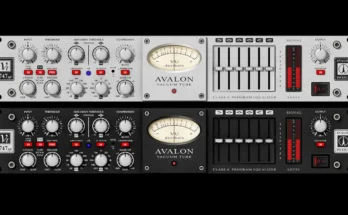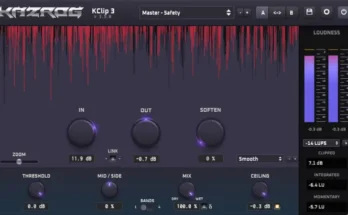23.10.2018 | x64 x86 VST WiN | 10 MB
Microtonal Polyphonic Shiny Dirt is a free polyphonic VST microtonal Windows synth from Michael W. Dean of BipTunia. It’s very easy to use. Yet it is robust, and will give you power.
Microtonal Polyphonic Shiny Dirt has 128 pre-sets, and 5,376 microtonal tuning options.
Microtonal Polyphonic Shiny Dirt is a no-nonsense introduction to microtonal synthesis, and it’s very musical. This synth is great for heavy bass, forceful leads, crystalline chimes, and more.
TIP: Don’t be afraid to experiment with microtonal music if you don’t yet understand the math.
While eventually learning the math is good, and we included resources for that. And with this VST, no math is even needed to start making cool microtonal music.
In fact, an ability to create compelling music with a tiny bit of understanding of microtones will go much further than the opposite.
Microtonal Polyphonic Shiny Dirt….is a very musical homage to circuit-bent analog synths. This VST is microtonal and polyphonic, but is also all about the mod wheel. The mod wheel does something different on each pre-set.
To Use:
Unzip and put the folder \MicrotonalPolyphonicShinyDirt inside your DAW’s VST folder.
System Requirements:
Microtonal Polyphonic Shiny Dirt is a 32-bit Windows synth, but it tested fine on 64-bit Reaper, and of course also on 32-bit Reaper.
It should work on any 32-bit DAW, and on many 64-bit DAWs.
In 64-bit Reaper, the presets will show up in a second window (If the window on the right isn’t wide enough to see all the preset names, you can grab either side of it with your mouse, hold down the left mouse button, and drag the window wider).
If you can’t even see the main colorful window with the kitties, click the button on the VST picker that says “Show UI” (user interface).
Getting to know Microtonal Polyphonic Shiny Dirt
So… this VST has 128 presets, and 5,376 tunings.
The first 32 pre-sets are microtonal. The rest are in normal tuning, but will retain the last microtonal tuning you used, until you set your own tuning (more on that in a moment).
Each preset has a different tuning, but you can use the picker to add any of the tunings to any of the presets. You can also make your own synth patches. And, if 5,376 tunings isn’t enough, you can add your own tunings. Put them into the \MicrotonalPolyphonicShinyDirt folder inside your VST folder. You can make your own scales using Scala, which is free.
The order of tuning files in our presets are set up somewhat randomly, to encourage experimentation. But you can stop using the set tunings in a given preset at any time, and pick your own. You do this by clicking on the file picker near the bottom right, on the “CHOOSE TUNING” section at the bottom, and picking any of the 5,376 scales.
The archive also includes Sevish’s PDFs about many of the tunings, included at his suggestion. They are a great read. Very educational, but not at all dry (Check out Sevish’s Resources for Microtonal Musicians page).
If you read about a tuning you like and want to try it, you can click the file picker icon in the bottom right of the User Interface.
This will open up the list of tuning files. From there you can just go down the list and try different scales, or you can find specific ones; there is a search function where you can type the scale name. It will bring up your result or results.
From there, click on the file icon to use the scale (Where it says hulen_33″ in the above image. But it will be replaced by the name you searched).
Tip: If you want to play in typical western 12-tone equal temperament, pick setting 33, called “NOT MICROTONAL.”
Wheel Choice Panel:
PM DEPTH Zzerp.
INPUT 1 Newman.
PITCH Moo.
RESONANCE Rez.
SIGNAL (Moog, signal – not on panel).
PHASE MOD Subtle.
MODULATION fBack – {is delay feedback).
PULSE WIDTH LFO drop down, bottom choice.
Microtonal Polyphonic Shiny Dirt has a cool frequency meter, and. This is a diagnostic tool used while making a VST, but usually removed before outputting for the public. I like it, so left it in. It’s stoney and groovy. But they also teach you a bit about how this all works, and what audio synthesis actually is.
The mod wheel on Microtonal Polyphonic Shiny Dirt is unique. It controls a combination of sustain, phase mod, and pulse width. It’s somewhat more subtle than many expect from a usual mod wheel, but very useful in creating a shimmer or vibrato by hand.
The mod wheel will do more on some presets and patches than on others. And will do more in some octaves than on others.
We recommend you try patches and tunings you like in different octaves as well. And with single notes, two- and three-note chords, and also try chords with more notes.
This synth will also produce very interesting results with an arpeggiator. Try it.
The pitch wheel on your MIDI controller will control pitch. The amount you can bend with it is different on some presets, and can be changed manually with the “Pitch Wheel” switch.
[toggle title=”Home page”]https://goo.gl/DcWsHV[/toggle]

http://alfalink.to/1c7fc92b4e56daf8abeb
Please REPORT in Comment Broken Links




